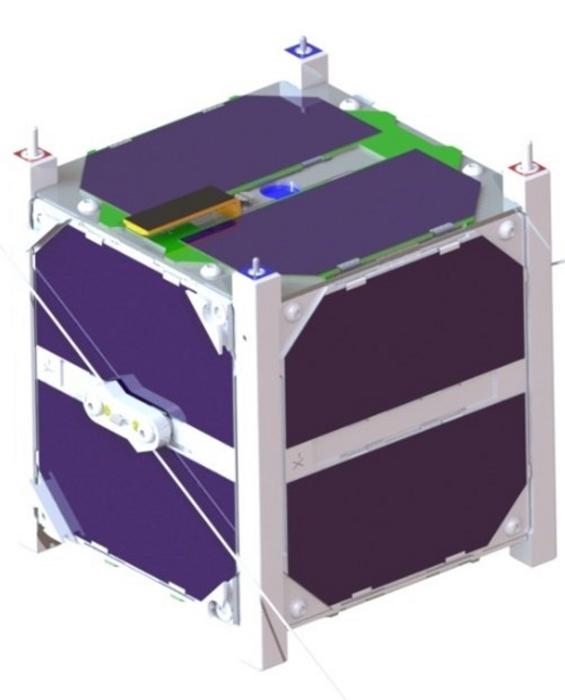The Luxembourg Institute of Science and Technology (LIST) announces the launch of its CubeSat project LIST-SAT-01, the first Luxembourgish nanosatellite initiative with a scientific experiment on-board made in house, aimed at showcasing the institute’s technology innovation in the space environment. Under the mission of testing and advancing technologies developed at LIST, the CubeSat project seeks to increase their Technology Readiness Level (TRL) and achieve flight heritage of on-board technologies.

Credit: LIST
The Luxembourg Institute of Science and Technology (LIST) announces the launch of its CubeSat project LIST-SAT-01, the first Luxembourgish nanosatellite initiative with a scientific experiment on-board made in house, aimed at showcasing the institute’s technology innovation in the space environment. Under the mission of testing and advancing technologies developed at LIST, the CubeSat project seeks to increase their Technology Readiness Level (TRL) and achieve flight heritage of on-board technologies.
Harvesting energy in space
At the core of the CubeSat project is a technological demonstrator, a nanosatellite weighing 1.2 kilograms, which will include a payload made of a thermal energy harvester integrating pyroelectric materials developed within LIST. This LIST technology has recently received the prestigious European Research Council (ERC) Advanced Grant, which is awarded to Europe’s top researchers in a highly competitive process. “The scientific goals of the CubeSat project revolve around demonstrating the technology of an energy harvesting system,” said Olivier Bouton, project manager. “The satellite will harvest energy from temperature cycles induced by its orbit.” As the satellite orbits the Earth, its orientation will vary —sometimes facing the sun, receiving solar radiant heat, and at other times obscured during an eclipse, allowing it to cool down. Consequently, it will experience fluctuating temperatures along its trajectory, resulting in a temperature profile with maximum and minimum values. “We will leverage this temperature modulation to harvest energy,” he added.
The CubeSat will house three distinct technologies developed by LIST:
- Pyroelectric Energy Harvester: A system that produces electrical power from heat modulation in space.
- Super Black coating: A perfect blackbody designed to efficiently absorb and emit thermal radiation.
- Inkjet Printed Sensors: Thermal gauges printed on parts of the spacecraft to monitor the payload experiment in the space environment.
Essentially, the project aims to demonstrate the system’s performance in space of these three LIST technologies operating together for the same energy harvesting system. The black body, designed to absorb solar radiation efficiently, heats up during exposure to the sun and emits that heat during eclipse periods, enhancing overall energy capture. This energy harvesting system aims to benchmark the possibility of complementing traditional photovoltaic panels with a more efficient alternative, while also mitigating the sensitivity to both radiation-induced degradation (Total Non-Ionising Dose) and ballistic impact of orbiting debris in space.
A solid research collaboration
The CubeSat project is a result of a research collaboration between four partners. LIST as coordinator and CSUM (University Space Center Montpellier, France) being the main contributors. The project will also engage with the Radio amateur clubs F8KGY ARRT (Thionville, France) and ADRAD Kayldall LX9AK (Rumelange, Luxembourg) for radiocommunication between the CubeSat and the ground station.
CSUM has recognized expertise in design, development, testing and operation of nanosatellites, as well as in project management and product assurance dedicated to university space projects. The satellite will be based on their existing space-qualified platform.
The launch of the CubeSat in space is scheduled for January 2026, following the project’s initiation in September 2023. The timeline includes the definition and specification of the system in 2023-2024, system production and debugging in 2024-2025, qualification tests in late 2025, and the mission’s operation in space after launching in early 2026, lasting at least one year.
“This project brings together complementary expertise and skills of different teams within the department of Materials (MRT) of LIST,” said Jérôme Polesel, Technology and Innovation Manager at LIST and scientific coordinator of the project. “It is the first time that such energy harvesting technology will be implemented in a satellite, aiming to synergize our different know-hows. This flagship project is truly a big source of motivation for our technical staff.” The CubeSat project also aims to create opportunities for further development of payload technology and pave the way for future demonstration missions of other LIST technologies. “As one of the first scientific Luxembourgish nanosatellites, the initiative aligns perfectly with the materials department’s strategic initiative’s “Flagship demos” objective, which focuses on highly ambitious real-scale demonstrations of advanced end-products,” added Jérôme Polesel.



